-
STUDENT HOUSING

Student housing takes on many forms around the world, but most commonly, it’s envisioned as close quarters in a bleakly designed dormitory. While prospective students choose universities based on academic rigor, athletic programs, extracurricular activities, and future career opportunities, they’re now wanting to know what living on and off-campus will be like- and it has forced designers to rethink the traditional designs of dormitories into something more innovative that better reflects what students want in their university homes.

Student housing in the pasty typically lacked any sort of real design emphasis. Small boxy rooms, shared bathrooms at the end of the hall, and tiny bunk beds are probably the images that come to mind when you think about dormitories. But these spaces, back then, were designed really to be slept in and store a few key items, while lounge spaces were meant to hold social gatherings, dining halls for eating, the athletic facilities for exercising, and libraries for studying. Dorms were built cheap, because they didn’t cost much to live in, and didn’t need to contain many amenities.

But today, there’s a much different expectation for student housing as we explore changes in the way that people want to live. Most rec, collegiate dorms caught major headlines when the University of California, Santa Barbara unveiled their plan for a massive new student housing project. The design was driven by a wealthy donor who gifted 200 million dollars to the school for the project. This mega-dorm caused such severe backlash that even the architect who was slated to draw the project resigned. The issue at hand was that the 1.68 million SF structure would be home to nearly 4,500 students with only 6% of them having direct access to windows. By filling the interiors with small rooms, the intent was to bring students into social spaces to relax and collaborate- almost ignoring the issue of the remaining 94% of students having access to light and fresh air.
NEELKAMAL VISHWAKARMA, AR-17-079
PRAJAKTA THAKUR, AR-15-071
-
Are PREFAB – Construction The Future of ARCHITECTURE ?
Author : Unnati Yadav
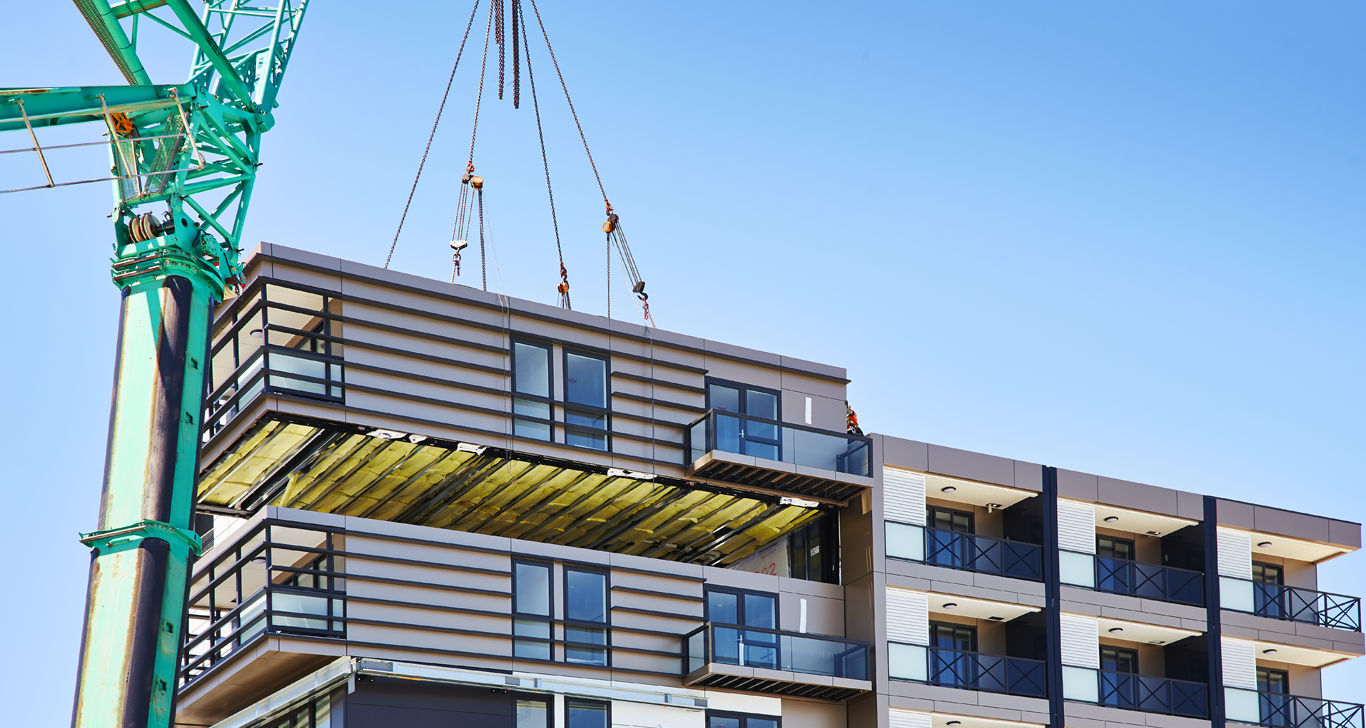
Introduction of new technologies and innovations are observed always as we leapt through time. One of them currently trending into architecture and solving the issue of time of construction is debut of prefabrication construction.
Prefabricated construction is the practice of assembling a variety of components of a structure at a manufacturing site and transporting those sub-assemblies to the location of the construction site. Prefabricated construction is sometimes thought of as a low-end and mass produced mode of construction.
Panelization is another form of prefab, but it requires a bit more work on site. Panelization involves walls, floors, and roofs being constructed in a factory before being transported to the build site. Those elements are then attached to the structure that already exists on-site. Plumbing and other infrastructure is installed afterwards.
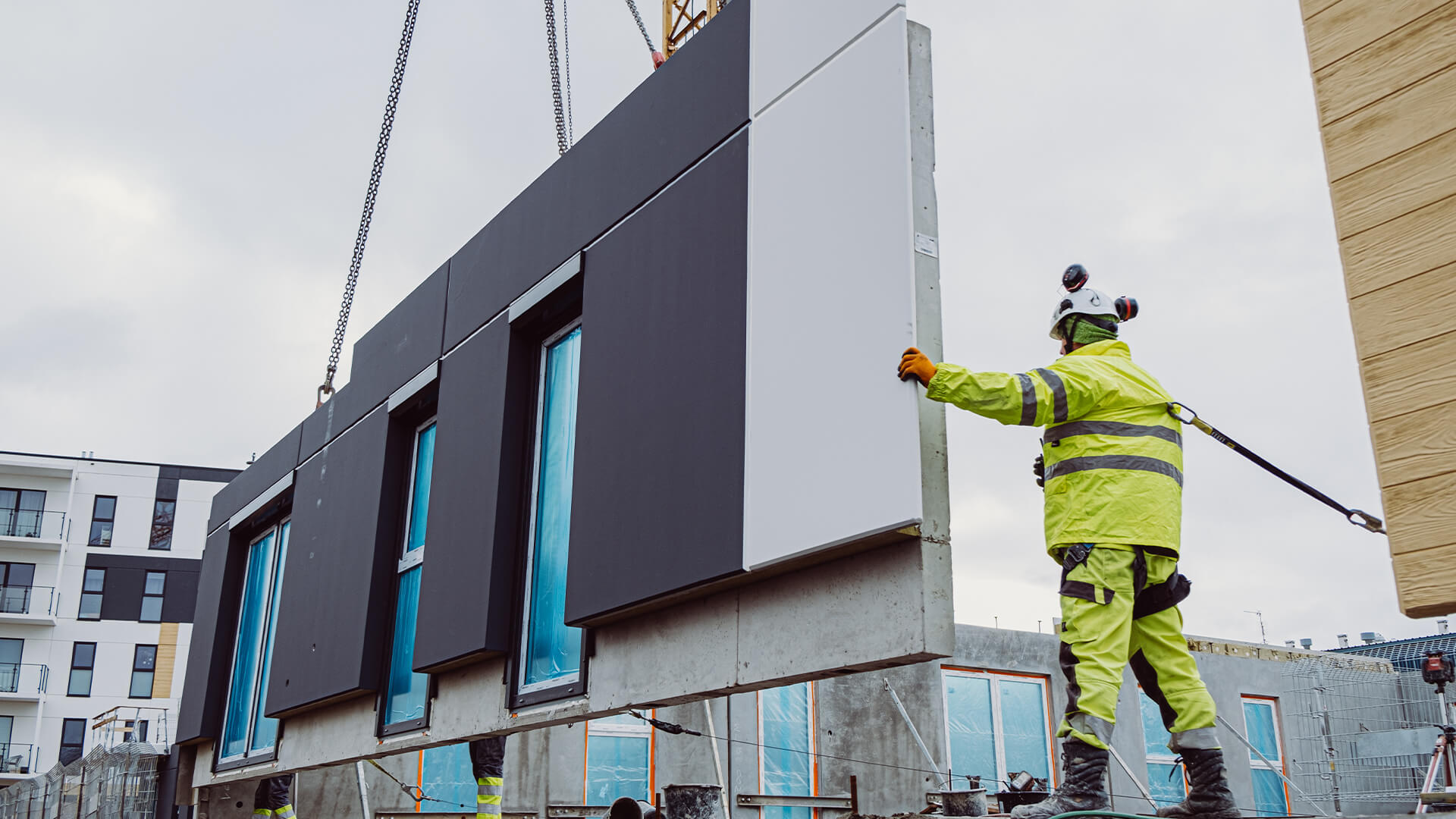
Modular construction is a category of prefabricated construction though often conflated with prefab. It entails building entire sections of a project before shipping those pieces to a site. This includes plumbing, electric, and everything else needed for a function unit.
Modular construction : from manufacturing to site installation This method requires the least amount of on-site work, and the most specificity. Following are the pros of prefab :
-Cost effective
-Reduces environmental impact
-Especially helpful to projects with a high degree of redundancy.
-Reduction in amount of labor for the project & easy to assemble.
-Reduction in time of construction
-Quality & sustainable construction

STRUCTURE : Yellow House / Alejandro Soffia “The hypothesis is, that if you create a prefabricated system which has a good architectural design, then you can reproduce this quality as much as you need it, within the laws of short/long production series. And if in the serial industrial production of buildings you get bored, you can also customize form and function through the system. More benefits when you fasten the building process and have more control over quality and cost.”
With the continued popularity of prefabricated construction, it is likely that it will only continue to grow in popularity. Customers who choose this option are able to enjoy a high quality, quicker, cost-effective, and eco-friendly construction method. Furthermore, construction companies may soon increase their investment in modular construction processes, benefiting both their business and customer relationships. Prefabricated construction is proving to be an extremely viable option, and as manufacturing technology continues to improve, expect to see its benefits and advantages rise in the future.
SOURCES :
https://www.archdaily.com/872383/5-projects-that-illustrate-the-huge-potential-of-prefab
-
TEMPORARY ARCHITECTURE
-
DYNAMIC BUILDING FACADES
AUTHOR: Antheia Crasto I Mrunal Deshmukh I Bhumika Suthar
February 15, 2022
Innovation in architecture has been constant throughout history from simple caves that served the purpose of individual shelter to today’s public spaces that serve to the collective multidisciplinary functions. It is evident that architecture has been judged by its façades which makes it one of the important characteristics of a building. It gives identity to a particular architectural style or an era in history. This makes innovation in traditional facades vital to not only serve today’s modern trends but also evolved functions of a built form
Building facades primarily act like a skin, an intermediate between the interior and the exterior. They shield the interiors against environmental factors and play a role in energy efficiency to provide comfort that enhances the productivity of its users. In contemporary times the traditional facades necessarily do not serve today’s complex functions and at the same time it’s sustainable needs. here the technological advancements play a vital role for managing the building systems efficiently. A building façade is exposed to changing environmental factors. In responsive facade system the building façade changes its character according to the need of the building minimizing energy consumption and giving the building its unique character or identity.
User control facade – Kiefer Technic Showroom, Austria (2007)

It is a simple technology which responds only to the use input from the building occupants. The façade itself is functioning as a shading device but given the users to control the angle of the panel, and amount of light transmission.
Lighting projection – Galleria Centricity by UNStudio (2010).

The strategy consists of creating an optical illusion. The facades feature two layers of customized aluminium extrusion profiles on top of a back layer of composite aluminium cladding. This results in a wave-like appearance, which changes with the viewpoint of the spectator
Light Control Dynamic Façade- Abu Dhabi’s 25-story Al Bahr Towers

Each of the 1000 panels is connected to a linear actuator which enables it to function in response to the position of the sun, effectively reducing heat gain and glare by 50% while giving Islamic vernacular a contemporary representation.
Seasonal Green Dynamic Façade – Travessa Do Patrocinio in Lisbon, Portugal (2012)

The walls are completely covered with vegetation, creating a vertical garden, filled with different varieties of vegetations.
Wind Responsive Dynamic Façade – Domestic Terminal Carpark in Australia (2011)
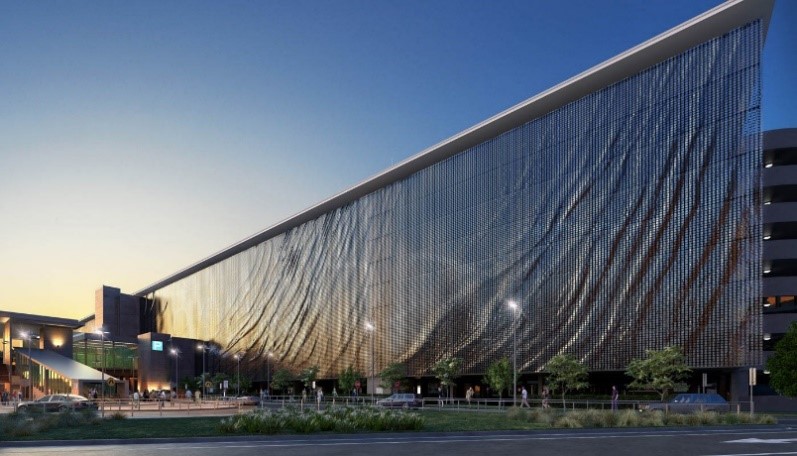
This structure has installed 250,000 aluminium plates to create this wind-powered façade without wasting energy. “Viewed from the exterior, eastern side appears to ripple fluidly as the wind activates 250,000 suspended aluminium panels.
The intermediate skin has been defined through mediums of kinetic facades, green cover, Energy efficient facades and interactive facades. As the needs evolve there is a scope in use of different other mediums to define this intermediate skin which in turn defines the architecture for that period as ornamentation in facades was a sign of hierarchy in ancient architecture , Glass facades a sign of prosperity, and energy efficient facades as a response to the present and future deteriorating climatic conditions.
References:
https://www.archdaily.com/69219/uap-ned-kahn-to-create-kinetic-artwork-for-brisbane-airport
https://www.arch2o.com/dynamic-facades-the story
https://www.slideshare.net/jalsai/07-responsive-facade-for-energy-efficiency-in-building
-
NATURE OF UNCONSCIOUSNESS
AUTHOR: Dimple Shah I Sneha Singh I Muktika Verma
February 11, 2022
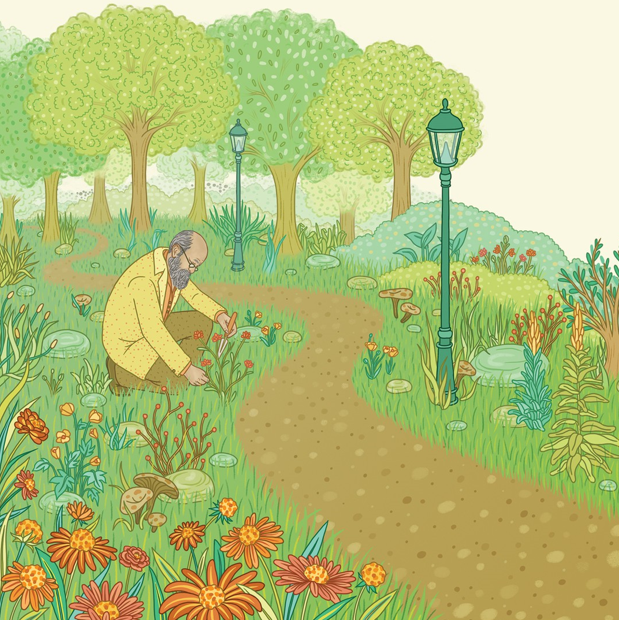
Searching for beauty in nature
Illustrator: Gaby d’AlessandroFrederick law Olmsted – Landscape Architect, was an American landscape architect, journalist and social critic and public administrator. Olmsted was famous for co- designing, many well-known urban parks with his senior partner Calvert Vaux. Olmsted retired in 1895. During his 38-year career he completed numerous projects, including residential suburbs, city squares, park systems, scenic reservations and university campuses.
The two writers who most influenced his thought on this subject were the eighteenth-century Swiss physician Johann Georg von Zimmermann and the prominent theologian of Olmsted’s own time, Horace Bushnell with their teachings concerning the unconscious influence of landscape. Olmsted realized that he had learned much about scenery from his father’s silent appreciation of it, and with the theories of Zimmermann and Bushnell to produce his own theory of the effect of scenery on man. He worked by an unconscious process to produce relaxing and “unbending” of faculties and the necessary condition for such an experience was the absence of distractions and demands on the conscious mind. The effect came not as a result of examination, analysis or comparison, nor of appreciation of particular parts of the scene; rather, it came in such a way that the viewer was unaware of its workings. So as long as considerations of utility are neglected or overridden by considerations of ornament, there will be not true art.

“Service must precede art” Introducing such concept in today’s growing urban fabric would enhance and engage people together in an unconscious way, which is a current need. The composition should artfully insert a variety of uses into logical precincts, ensuring the best possible site for each use and preventing competition between uses. The composition should be comprehensive and seek to have a healthful influence beyond its boundaries. In the same way, the design must acknowledge and take into consideration what surrounds it.
-
Sustainability & Vertical Cities
An approach to architecture that seeks to connect building occupants more closely to nature.
Author: Aniket Karambele (AR-17-034), Riddhit Pathak (AR-17-056), Archit Raut (AR-17-058)
Dated: 11 February 2022.
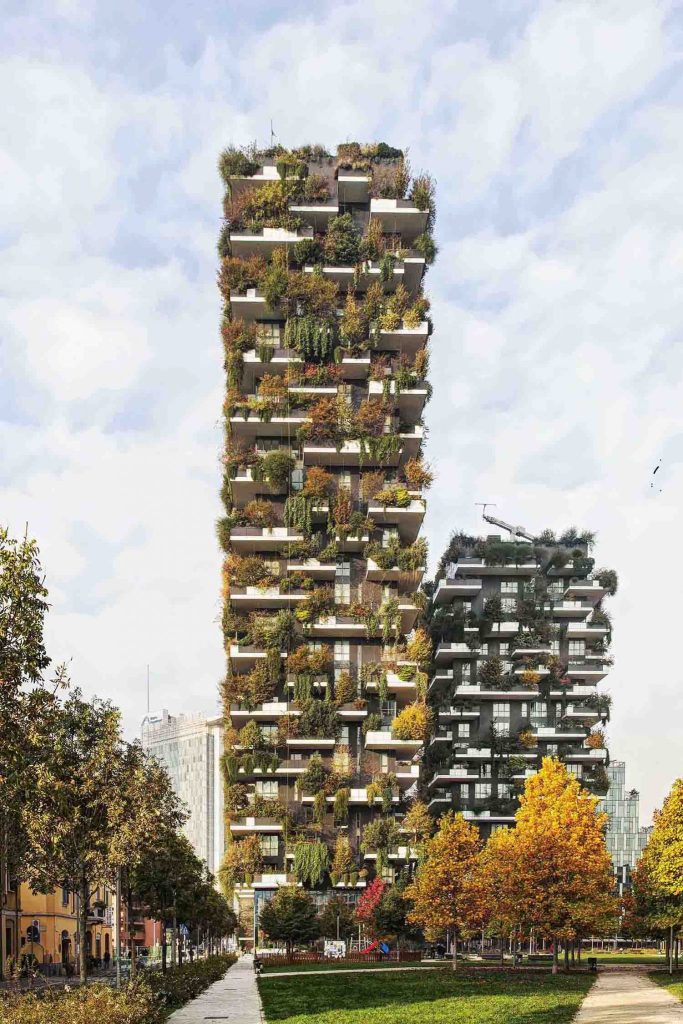
Figure 1: The Vertical Forest, Boeri Studio (Stefano Boeri, Gianandrea Barreca, Giovanni La Varra) Sustainability
The key to a more environmentally friendly future is sustainable architecture. We can only expect to protect our ecology and climate by living more economically with our resources.
Sustainable building is based on the idea of reducing waste. This includes not only reducing physical waste but also reducing energy loss. We require less energy supply in the first place if we can hold the energy we consume within our structures for as long as possible. We can become more environmentally responsible and resource efficient by using less energy to keep ourselves comfortable, which is critical in mitigating the consequences of climate change.
When it comes to creating buildings that are more environmentally friendly, there are three major problems. The first concern is the construction materials. The building’s energy efficiency is the second worry, and the placement of the building is the final consideration. The structure may be energy efficient and constructed with low-impact materials, but it won’t matter if the ecosystem suffers as a result of its construction. In popular architecture, a more holistic approach to all of these design considerations is becoming more common.
Vertical cities
As the world’s population rises and environmental changes reduce the quantity of usable area on Earth, land is becoming scarce. The solution, according to some creative thinkers, is to build up.
Cities will need to become more space-savvy in order to remain sustainable, making room not only for additional commercial and residential areas, but also for infrastructure and public services that can cope with rising population, such as highways, schools, and hospitals.
The constant reduction of our arable land and natural resources, climate change, fast population increase, and environmental damage are among the pressing and tough concerns that humanity is currently facing. Through technology and our growing interconnectedness, we have more opportunities than ever to make the world a better place.
While the concept of vertical cities is gaining traction, vertical farming is already a reality, bringing us one step closer to our future high-rise urban homes.
Many horticulturists and businesses see controlled farming as a remedy to the negative environmental effects that traditional farming can have. At the same time, as the population grows and available farmland shrinks, it is necessary to meet the growth in demand.
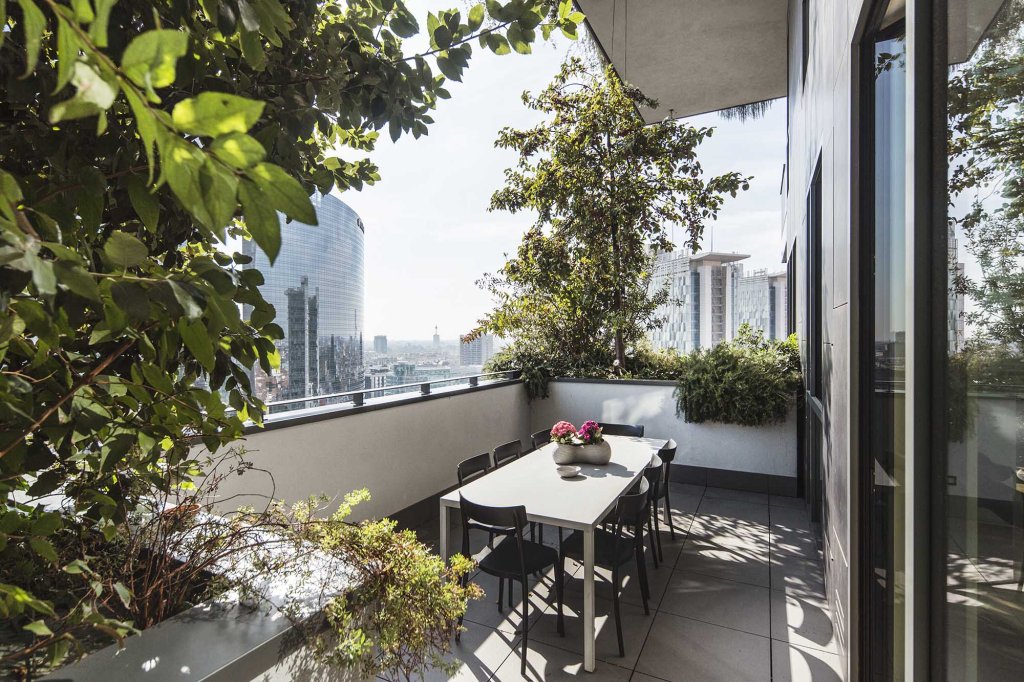
Figure 2: Balconies designed to accommodate large external tubs for vegetation and to allow the growth of larger trees without hindrance 
Figure 3: the façades can be viewed as three-dimensional spaces not only because of the denseness and function of the green curtain but also in aesthetic-temporal terms, due to the multi-coloured cyclical and morphological changes in the size of the plants. 
Figure 4: Bosconavigli was designed and developed to provide the best possible spatial benefits both for those who live in the area and temporary residents, promoting interaction and exchange between the numerous different characters active in the district. 
Figure 5: The entire architectural structure allows users to interact with spaces characterized by public and private greenery, with systems of loggias, tree-lined terraces and communal collective spaces. Architect’s Point of view,
Ar.Jean Nouvel encouraged sustainable architects to think about how their design might adapt to long-term changes: “More than ever, sustainability is at stake…We live in a world of constant and profound transformation, so architects have to radically rethink the way we build. New expressions need to reflect new paradigms and the rise of technology. We have to project our ideas far into the future, they need to stand the test of time.”
In conclusion, a sustainable city is one that uses urban planning and administration to address social, environmental, and economic impacts. Many sustainable measures, such as the adoption of pedestrian and bike lanes, are made possible by incorporating environmentally acceptable options into local infrastructure. Regulations and fines can also be used to effect change: garbage removal orders have been shown to reduce landfill waste.
A vertical city is a complete human habitat compressed within a massive skyscraper. Vertical cities hold the key to addressing overcrowding and overpopulation. Vertical city refers to the development of this type of city on a vertical scale. It is primarily concerned with accommodating a large population on a small piece of land. It is distinguished by high-rise buildings, compact development, higher physical densities such as FSI, small open spaces, and low ground coverage, among other things. Basic services are simple to provide in this type of city. They require less land to develop.
Source:
-
SPONGE CITY
Tackling the Issues of Pertinent Water Shortage and Flooding Crisis in Cities around the World
Authors: Abhijit Kumar Arora (AR-17-004), Vedanta Dhoundiyal (AR-17-017), Pranav Joshi (AR-17-033)
Dated: 11 February, 2022

Figure 1: Xiangyang Han River Eco-City Masterplan | Riverfront Wetland A Sponge City indicates a particular type of city that does not act like an impermeable system not allowing any water to filter through the ground, but, more like a sponge, actually absorbs the rainwater, which is then naturally filtered by the soil and allowed to reach into the urban aquifers. This allows for the extraction of water from the ground through urban or peri-urban wells. This water can be easily treated and used for the city water supply.
Primarily as a response to the increasing flood impacts, the Chinese Central Government called for widespread uptake of the Sponge City approach across China in 2013 and provided financial support to foster the implementation of this approach in a selection of pilot cities. At present, the Sponge City approach is gaining ground and becoming more and more accepted by city governments.
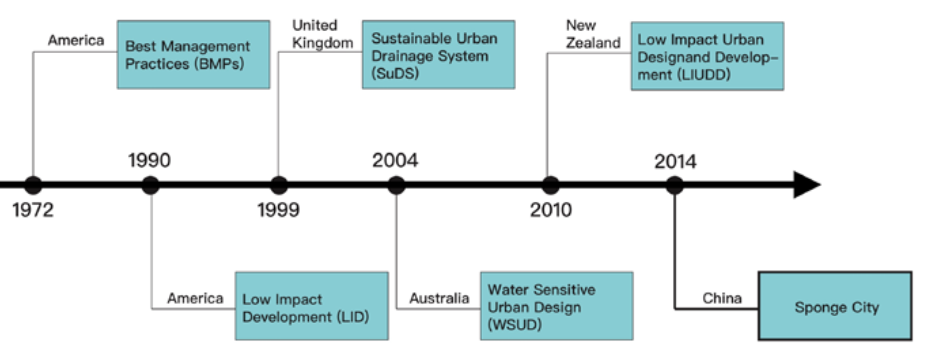
Figure 2: Timeline Showcasing the Evolution of Sponge Cities around the World The idea of sponge cities was initially developed by Professor Kongjian Yu, stemming from his work in landscape architecture at Harvard University and his desire to tackle flooding issues in Chinese cities. The design proposes the integration of multiple LID (Low Impact Development) measures such as adding vegetation, a small water square, porous pavement, and a green façade.
Sponge cities aim to promote positive interactions between socio-economic systems within the cityscape and with the urban water cycle to enhance local urban resilience, particularly in the face of increasingly volatile water-related disasters. In major Chinese cities such as Shanghai, Shenzhen, Wuhan, and Beijing, the intent of the concept is to reuse 70-80% of rainwater from these recharged grounds by 2034.
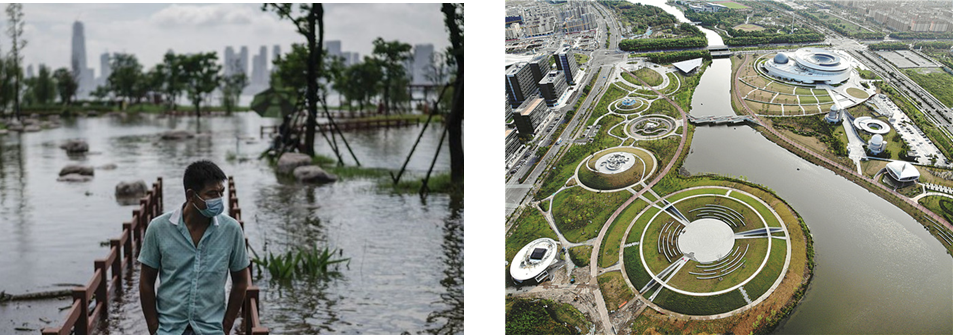
Figure 3: Lingang area after flash floods in Shanghai, 2012; Shanghai Astronomy Museum Park The Erqi city district is located in the very center of Wuhan and is therefore very accessible for multiple types of transport. The area is located between the first and second beltways of the city. Two roads run parallel to the beltways connecting them and making the area very accessible by car. Furthermore, the area is well connected by metro and tram lines. The metro line passes through the middle of the city district going from east to west and the tram line is constructed in the middle of the center road, going from north to south. It is the incorporation of Bioswales and the Sponge Model in the Tram Lines that makes it unique and sustainable.

Figure 4: Incorporation of Bioswales and the Sponge Model in the Tram Lines of Erqi, China 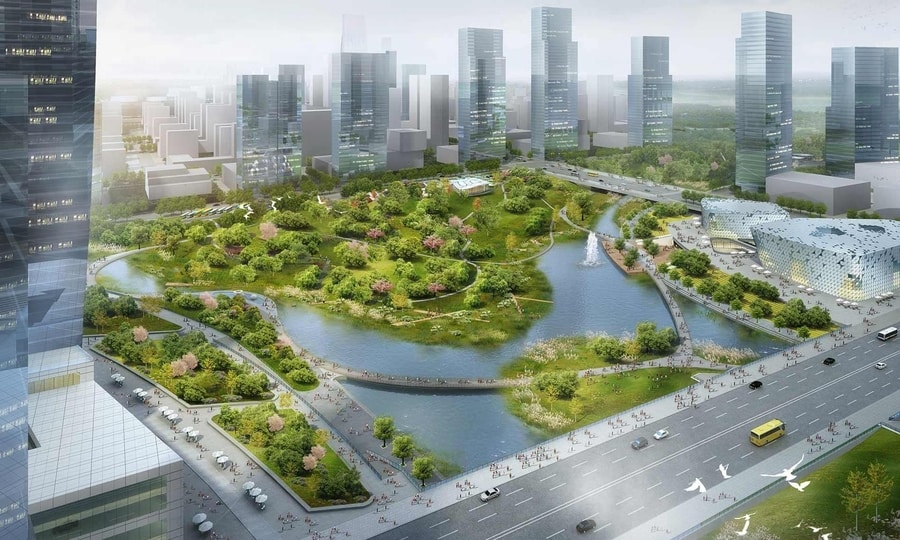
Figure 5: Hangzhou West Station Development Plan on the lines of the Sponge City Model 
Figure 6: The Sponge City Model can also be incorporated, especially for Mumbai, where prolonged annual rainfall causes major flooding woes/havoc In Conclusion, the Sponge city concept is a strong contender as a solution to the current and future water struggles in China. It represents a shift in environmental governance and planning in China, focusing on the increasingly evident impacts of years of resource exploitation and rapid urbanization and seeking to mitigate the damaging implications from flooding, water shortages, and pollution. It also promises an accountable form of urban planning that steps away from green-washed eco-city plans to a more eco-centric version of China’s ecological civilization, following a wider global trend in environmental and green-oriented developments. However, the sponge city pilots have also highlighted a range of implementation challenges, such as governance issues, uncertain financing, and out-of-date or unavailable urban design that will hinder its implementation and its subsequent effectiveness and legitimacy. The concept is ahead of its time, and much research, policy changes, and investment opportunities are needed to resolve the range of challenges for its impactful implementation.
SOURCES:
https://earth.org/sponge-cities-could-be-the-answer-to-impending-water-crisis-in-china/ -
HYBRID AND FLUID SPACES
The Future Of Better Housing And Community
VAISHNAVI KUSHTE
KSHIPRA TULSYAN
Since the beginning of time, the rooms in a house have been divided into grids and assigned specific functions. Such houses are primarily used for living purposes without including working and studying spaces.
But, according to architects, those barriers are disappearing. Future spaces will become fluid, shared, multifunctional, and multipurpose, and single-purpose locations will become obsolete. It’s not only healthier and better to live that way, but we are also smarter about design and more considerate about how we use space. “The pandemic has given us a new perspective on barriers we have been using for years. The physical impact of the pandemic is far lesser than the impact it has had on our mental state and well-being. A lot of existing real estate is underutilized and not very effective, so the principles of mixed use can be a bridge to provide more attainable, more secure, comfortable housing.”
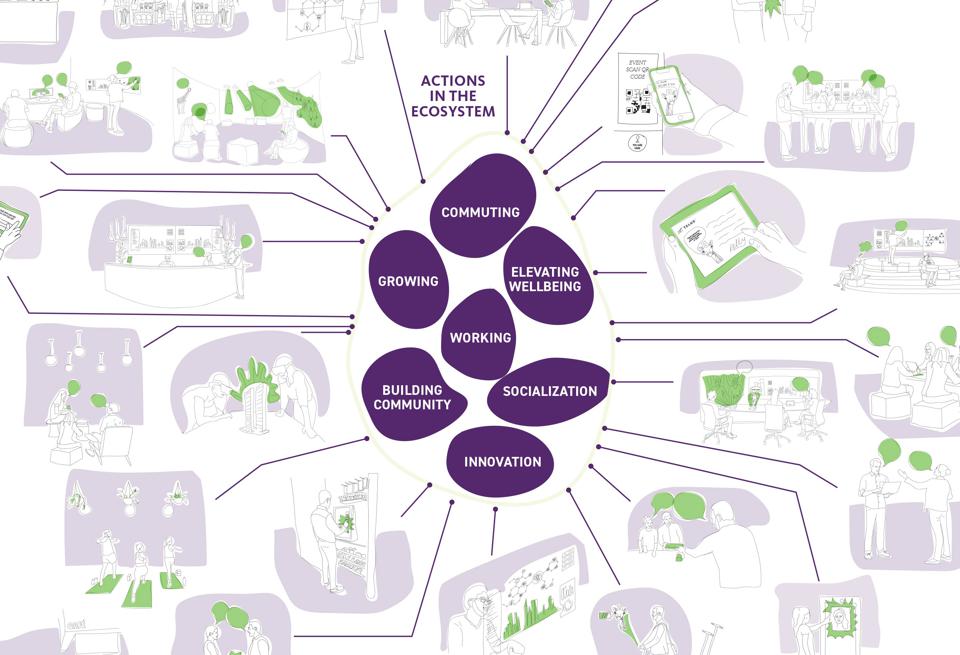
TELUS Work Styles (R)Evolution Planning Concepts used to design thoughtful spaces.
GENSLERHYPBRID AND HEALTY HOMES
Flexi homes are becoming the new normal during this time when the pandemic has locked us inside our houses. The Flexi home solutions are enabling people to adapt to a more time-focused lifestyle. A recent study states that post lockdown announcement in March 2020, around 70% of people have reported revamping their houses and the environment they live and work in.
3 of 5 study participants reported that it has become more difficult to balance their work and personal lives as their work and personal lives have merged, and the ‘personal space’ even at home has disappeared. Although the pandemic has taken so much from us, it has also given us the opportunity to spend time with our families. The community lifestyle of the pre-pandemic era was unimaginable.
People are now exploring ways to restructure the indoor environment to make it multi-functional post-lockdowns, which has impacted how people live, work, interact, and sustain. Multifunctional houses or smart houses will meet the demands of today such as areas for working, exercising, relaxing, and rejuvenating.
Due to the fact that households spend more time together, there’s a demand and need for homes that can be adapted to meet the changing needs of people who live, work, and earn in their homes. Property decisions today are based on a number of factors, including indoor space, sunlight amplification, ventilation inside the house, air and water quality, proximity to essential services, and so on.

Future office spaces Currently, even the temporary solutions by realtors, designers, and architects are increasing the functionality of homes to ensure that designated corners within the home, such as the dining room, garden, bedroom, or study can be used in multiple ways.
Similarly, the industry is evolving – many brands now offer movable walls for people to convert their homes into offices, and then convert their homes back again.
Many families have transformed their homes into flexible multi-functional residences as the country is experiencing the worst phase of the Covid-19 outbreak. It will no longer be about planning a simple one- or two-bedroom house for people to live in. Rather, it will be more about structuring the home and interiors in a manner that allows it to become a multi-functional space merging with the reality of the home being a space with more than one function.
HOUSING OPTION

Flexi housing typology The core of the dwelling is designed to be airtight and highly insulated. Using simple construction techniques, residents can construct additional structures based on their needs. Since these elements are self-constructed and do not require insulation, they can be altered, amended, and removed over time.
The demand for alternative housing models is increasing, but homes will need to adapt. Through the use of assistive technology, homes can become adaptive, flexible, and able to adapt to changing needs throughout their life cycle. A larger room would also have space for a buggy or mobility scooter, wide doors, a walk-in shower, and a bathroom with an accessible entrance.
After a day of working from home in a different setting, the slack spaces give us organizational flexibility. Having additional space can be used to create a home office, a place for a friend or caregiver to stay temporarily, a place for a child of a single parent to spend the weekend, or a place for a hobby. The minimum number of rooms in a house is determined by the space standard. Post-Covid, perhaps that will change, so that an open-plan space you can configure to suit your preferences is more desirable as both a distancing mechanism and to create that much-required headspace.
Ref- https://www.designcurial.com/news/the-design-of-homes-post-covid-7981176
FLUID SPACES
Cities have grown horizontally and vertically for decades now. Experiments with materials, techniques, and forms have become easy to accomplish. We live in a world of plenty! Just a vague idea turns into a sketch and a massive building rises into the sky.
The global pandemic we are experiencing today is paused, and life seems to be stagnant. When life is paused, the future is uncertain, when we have to question literally everything, when we must strive for the basics. If we cannot move forward in this time, what should we do? Look into the past for answers! What did man in the prehistoric era do? ADAPT

Multiuse of spaces during pandemic Existing facilities that are now closed or underutilized due to the lockdown were converted into care facilities for Covid-19 patients. In India, we have seen famous stadiums turned into medical facilities and treatment centers for those who have been afflicted by this pandemic, with the main ground floor entirely dedicated to beds. Our trains have been converted into isolation wards, a remarkable adaptation.
Seeing how spaces have molded their functions is gratifying. This leads me to the question: Why shouldn’t spaces be designed this way? Can’t we design “function fluid” architecture?
In the future, spaces will be more fluid, shared, multifunctional and multipurpose, where a single place with a single function will no longer be relevant since we will be smarter about design and more thoughtful about efficient use of space.
BIBLIOGRAPHY
https://www.designcurial.com/news/the-design-of-homes-post-covid-7981176
https://www.tfod.in/art-design-articles/7956/fluidity-in-spaces–adaptive-trends-in-architecture
-
Modern Vernacular Architecture: A New Twist on Old Favorites
Written by Komal, Manasvi, Saloni
9th February’2022
Written by Komal, Manasvi, Saloni

Fig.1: Evolution ©Author Modern Vernacular Architecture considers the synthesis of modernity and tradition in contemporary architecture, it examines architecture that reinterprets rather than revives traditional forms, materials and construction techniques. The words “modern” and “traditional” are often considered as being in fundamental opposition to each other. One tends to suppose that vernacular architecture is a kind of traditional architecture, distinct from modern architecture. In this dualist view, the traditional is taken to be inept or technologically crude.

Fig.2: Characteristics Vernacular Architecture is expressed as the original architecture, arché-techné. It is generated by all cultures, in all places and responds to the basic need of people to adapt to their own habitat. It is made with the available resources, to find shelter and to highlight their cultural representations. It is ancient and contemporary, urban and rural, rustic and sophisticated, large and small.
Today, as the demand for sustainable architecture increases many architects and designers are investing their time and resources to decode the world of vernacular architecture around the world, so to merge traditional outlooks with modern techniques.
Concept
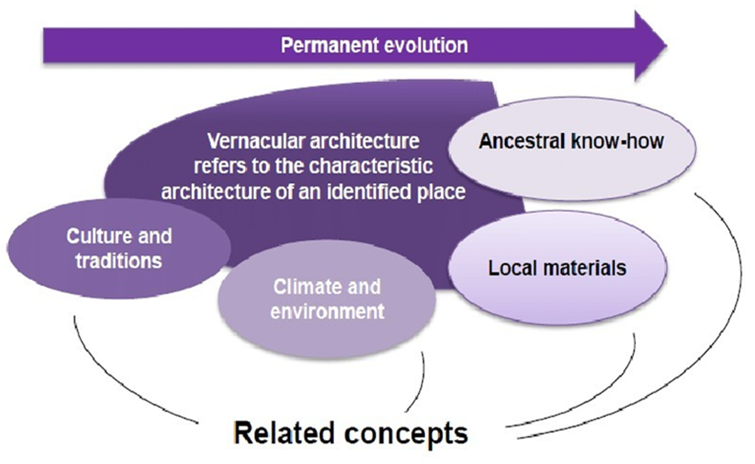
Vernacular Architecture adheres to basic green architectural principles of energy efficiency and utilizing materials and resources in close proximity to the site. These structures capitalize on the native knowledge of how buildings can be effectively designed as well as how to take advantage of local materials and resources. Even in an age where materials are available well beyond our region, it is essential to take into account the embodied energy lost in the transportation of these goods to the construction site. These structures present a climate-responsive approach to dwelling and are natural and resource-conscious solutions to a regional housing need.

Fig.3: Slate School Slate School, working with traditional wood materials and sloped roofs, but in new ways. Butterfly roofs bring more daylight into classrooms, glue-laminated beams achieve longer structural spans, updated rain chains combine contemporary art with traditional technique, and a simple wood pergola, reminiscent of a traditional porch, extends classroom spaces into an exterior courtyard.

Fig.4: Pearl Academy The Pearl Academy would be a perfect example to explore vernacular architecture, and not miss out on attributes of Rajasthan. The Academy uses several elements to create an ‘environmentally conscious passive habitat’ like step-wells which are a traditional way of cooling, along with jaali skins that filter air and light while ensuring privacy.
As an Architect…
Architects have a challenging responsibility to design buildings that are environmentally sustainable with the change in the global concern regarding the use of energy and resources. This new responsibility has prompted a sensible shift in trend from a biased preference of eye-catching, institutionalized forms to more organic, humble, yet energy-efficient vernacular forms. Additionally, the local forms of construction capitalize on the users׳ knowledge of how buildings can be effectively designed to promote cultural conservation and traditional wisdom.

Conclusion
The changes in culture and traditions imply the changes in vernacular architecture. Vernacular architecture is a continuous and evolving creation of life where continuities and discontinuities through its routes develop its own initiatives in the conditions of each period and area. For example, the traditional continuity that fabricated the buildings and spaces in the first place is being interrupted because of the new lifestyles.
This tends the buildings to be adulterated for better use or abandon or replaced by the new modern buildings. However, the extent of continuities and discontinuities to fit in the modern contemporary are debatable when traditional cultural values, traditions, and beliefs are concerned. Best is seen in the promotion of the continuities of the vernacular architectural practices with few reasonable adulterations and modern interventions for the sustainable development practices. Necessities of policies, design guides, norms, and skillets are seen for the moderations of both the continuities and discontinuities of the vernacular architectural practices in the outskirts.
AR-17-27,65,66
References:
https://www.sciencedirect.com/science/article/pii/S2095263514000715
https://www.archdaily.com/155224/vernacular-architecture-and-the-21st-century
Accessed: 9th February’2022
-
Importance of Vertical Outdoor Spaces
Architectural theory & Trend:
Importance of Outdoor spaces
“I DO NOT BELIEVE ARCHITECTURE HAS TO SPEAK TOO MUCH.
IT SHOULD REMAIN SILENT AND LET NATURE IN THE GUISE OF SUNLIGHT AND WIND “
_TADAO ANDO_
Knowledge about the TREND & THEORY:
One of the most popular architectural trends over recent years has been the prominent rise of living spaces that merge the indoors and outdoors together, seamlessly blending the lines between interior and exterior. In this way, the outside world is brought inside: views, the natural elements, and the environment are all made accessible, all year round, from a safe and warm space.
Cutting-edge building design can create amazing opportunities for bringing the outdoors in and connecting people to their beautiful surroundings; it’s all about taking advantage of the space around you and maximizing the potential opportunities.
Facts:
Ease of movement:
its ability to connect different forms of movement allows it to become vertical corridors in the sky – a semi-public and highly integrated transitional space that provides opportunities for more local and global connectivity with other buildings and transportation networks, and then rooting the sky courts in a network of open spaces within Urban fabric
Clarity:
Their location and shape within the high building must consider the lines of sight to ensure maximum clarity to provide greater spatial awareness among occupiers and visitors, promote ease of movement through the tall building and beyond, as well as place visual signals on the space of social interaction and co-existence

Adaptability:
Sky yards are often constrained by the footprint of tall buildings and the dominant force that regulates function and use. This could be a limiting factor in terms of adaptability and future use and puts sky court in the realm of privatized or semi-public space that bears the characteristics of the public domain.

Quality of public space:
Consideration should be given to the establishment of a vertical land ratio system that divides an open recreational space into a built area for the use of civil society completely, and that open space is a prerequisite for urban developments based on foundations. This could be a legislative part of the planning process, which will see the coexistence of the (private) developer and the state (public) in providing a quasi-public space for the Heaven Court for civil society to own.

Green facades and surfaces:
Adding green to urban design (the plan) provides the rationale, vision, and detailed implementation strategy of an economically sound and environmentally sustainable urban design. Urban design encompasses all exterior elements from the skin of the building to the street, including roofs, facades, squares, landscapes, open spaces, hallways, walkways, sidewalks, alleys, and roads. It is defined as those elements that are exposed to the environment and that affect the environment. (ADDING GREEN TO URBAN DESIGN).


Architectural Point of View: (Tadao Ando)
Thinking about verticality – A change of perspective expands space and opens for new points of view. This change also enables a new way of thinking about the future of urban open spaces. Because if we expand horizontal open spaces into verticality, we find new and inspiring perspectives. Considering urgent social problems and climatic challenges worldwide, these new approaches are more necessary than ever: How do we want to live together in the city of the future? We need to find new answers – especially spatial ones.
The basis of the design-based doctoral project is the consideration of the relationship between verticality and open space – in a first step separately with their specific characteristics and in a next step in the spatial combination: as “vertical open space”. In a first definitory approach, a “vertical open space” is a layered, accessible, exterior space “with at least two levels.
Till now, a systematic reappraisal of this type of open space has not yet been carried out. For a wider and conscious use of „vertical open space “in design practice, through the professions of Landscape Architecture and Architecture, specialist knowledge is essential. The design-based doctoral project aims at closing this gap and providing an overview of specific features of „vertical open spaces “in addition to basic principles such as categorization and definition.

Conclusion:
The ‘Renaissance of the Cities’ increases the density of metropolises worldwide. An ever-growing structural density leaves less room for new open spaces in the city. In addition, the urban population’s desire for more qualified open spaces is growing. It is harder to find places for new open spaces and thus it is time to leave the traditional ways of creating and developing new open spaces to take the chance to generate them where they were previously impossible.
The aim is to create a ‘plus’ of available open spaces in the same area and to use the opportunities of the z-axis in the urban development to raise once inaccessible space potential. The vertical open space is a symbiosis of built and open space, and therefore the combination of architecture and the objectives of landscape architecture.
Kunal Dinesh Chavan AR-17-010
Karan Sanjay Joshi AR-17-032
-
Subscribe
Subscribed
Already have a WordPress.com account? Log in now.